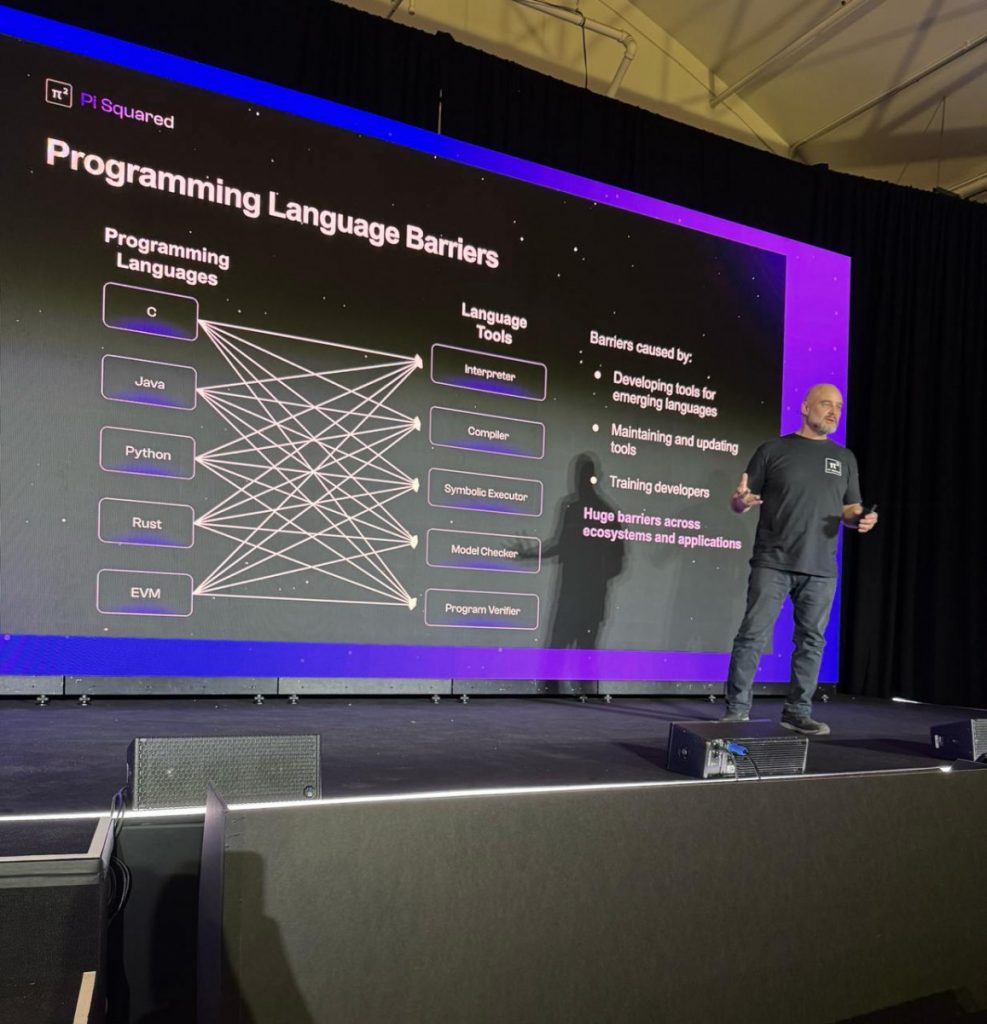Pi Squared Is Rewriting Web3 Without Blockchains


In Brief
Pi Squared is building a universal, verifiability-first infrastructure that makes traditional Layer 1s, Layer 2s—and the need to choose between them—completely obsolete.

Most people think of blockchain as immutable code and cryptographic signatures. Grigore Roșu sees it differently: as mathematics in motion. A veteran of NASA and a professor of computer science, Roșu is building Pi Squared—a radical reimagining of Web3 where every computation becomes a mathematical proof, verifiable by design.
In this interview, he explains why blockchains are just one use case for his “verifiability-first” stack, how AI agents can operate without ever touching a chain, and why the distinction between L1s and L2s might soon disappear entirely.
Can you share your journey into Web3? What led you to found Pi Squared?
I entered the Web3 and blockchain space in 2017. Interestingly, before that, I worked extensively in formal verification and formal methods, particularly on programming language semantics. These techniques were mainly used to analyze and prove the correctness of mission-critical software for clients like NASA, Boeing, and Toyota.
I had co-founded another company focused on runtime verification. We applied formal verification techniques to mission-critical software. Then, in 2017, Charles Hoskinson, the founder of Cardano, reached out to me and suggested that these same methods could be applied to verify smart contracts and protocols in Web3. I looked into him, and he was legit, and that’s how we started collaborating.
So we brought the rigorous software analysis techniques used in aerospace and automotive to Web3. That’s how I got started. I’m also a professor of computer science at the University of Illinois Urbana-Champaign, where I’ve been teaching these methods for over 20 years. I still collaborate with NASA as well.
How do you envision Pi Squared’s role in advancing Web3 through a verifiability-first infrastructure?
Web3 is all about verifiability. It empowers individuals to own and transfer their digital assets. But this raises a big question: what if programs malfunction, or worse, what if someone tries to maliciously steal assets? That’s where verifiability becomes crucial.
At Pi Squared, we apply decades of research in programming languages and formal verification to Web3. We generate mathematical proofs that smart contracts and other programs are functioning exactly as they should, according to their formal definitions. It’s the most rigorous level of software assurance we know, and we’re bringing that to Web3.
What are the main components of your verifiability stack (VSL, VLM, and Proof of Proof), and how do they work together?
The core components are the Verifiable Settlement Layer (VSL), Verifiable Language Machine (VLM), and what we call “proof of proof.”
Everything is built on mathematical definitions of programming languages and computing models. We believe—almost religiously—that you can’t talk about correctness unless you’re using mathematical definitions. This field of formal semantics has existed for over 50 years and is foundational to computer science.
In our system, every computation—whether it’s a program execution or a token transfer—generates a mathematical proof. Computation is deduction, reasoning. What we do differently is we verify the integrity of program execution by verifying the integrity of its mathematical proof.
“Proof of proof” refers to a zero-knowledge cryptographic proof of a mathematical proof. This is what gives our company its name—Pi Squared. Mathematical proofs are large but precise, and cryptographic proofs are small but efficient. By combining both, we achieve succinctness and correctness.
VSL handles verifiable computation settlements. VLM reduces any programming language execution to a mathematical proof. And proof of proof is the cherry on top—providing compact cryptographic evidence of correctness.
How does the Verifiable Language Machine handle cross-language interoperability, for example, multi-language swaps?
The beauty of the Verifiable Language Machine is that it reduces computations in any language to mathematical proofs. Once you’re working with math, interoperability is automatic.
Mathematics has been around for thousands of years, and it naturally allows for interoperability. You can use algebra in geometry, and vice versa. Similarly, if every program execution becomes a mathematical proof, all those proofs are interoperable. So by translating computation into math, we get interoperability for free.
What architectural challenges have emerged when building a universal ZK verification layer?
Our universal ZK verification layer has two parts: reducing computation to a mathematical proof and then generating a ZK proof from that.
The first part—formal semantics—is a mature field. The second part, translating mathematical proofs into ZK proofs, is newer and presents unique challenges.
Adapting ZK circuits to work with mathematical proofs was surprisingly not the hardest part. The big challenge was engineering an infrastructure that could generate these mathematical proofs in real time as a program runs—say, on the EVM. No one else is doing that, and that’s where Pi Squared stands out.
While most ZK projects create custom circuits for specific languages like RISC-V, we go from any language to math, and then from math to ZK. That’s what makes our system universal.

What major milestones are you planning in the next 12–24 months, especially around DevNet maturity and mainnet launch?
Our biggest upcoming milestone is the launch of our Mainnet, a large, decentralized validator network. We hope to have more than a million validators. Anyone can join, even with a laptop or phone.
Thanks to the efficiency of verifying ZK proofs, thousands of verifications per second can be done on everyday hardware. Once the network is live, the possibilities are endless.
We’ll build applications on top, like AI agents and even entire blockchains. In fact, our infrastructure is more fundamental than blockchains. We don’t distinguish between Layer 1 and Layer 2. We’re like a Layer 0—or even Layer -1.
How do you plan to onboard millions of developers to Web3 with your “Bring Your Own Language” approach?
With BYOL (Bring Your Own Language), developers can write Web3 applications in whatever language they’re already using: Java, C, C++, and so on.
This massively expands the developer base from the tens of thousands who know Solidity to millions who know conventional programming languages. You don’t need to learn Solidity or EVM to become a Web3 developer anymore.
What’s your vision for how a universal settlement layer can disrupt current Layer 2 architectures?
Honestly, L2s exist because L1s like Ethereum are too slow and expensive. But if you have a universal, verifiable settlement layer that can handle any computation in any language instantly, you no longer need to distinguish between L1s and L2s.
In our system, both become just applications on top of our infrastructure. Even voting, payments, and auctions can be done verifiably and decentralized—without needing a blockchain.
What’s your stance on the shift toward modular verification in contrast to traditional blockchain-centric Web3?
Traditional blockchains enforce a total order of transactions, like Bitcoin does, to prevent double spending. But that comes at a massive scalability cost.
Our approach is different. Each computation is independently verifiable and doesn’t need to be ordered. It’s like tree leaves moving independently in the wind. That’s the future of Web3.
Where do you see the biggest challenges in the convergence of AI and crypto, and how will Pi Squared’s VSL address them?
AI agents need two things from crypto: payments and state settlement. Both can be done without a blockchain.
Blockchains can offer those features, but at a high cost. Pi Squared’s VSL provides verifiability, decentralization, and correctness—all with uncapped performance. No waiting in line, no forced ordering.
By “unchaining the chain,” we create a foundation for AI agents to operate freely and independently, without sacrificing decentralization or security.
Disclaimer
In line with the Trust Project guidelines, please note that the information provided on this page is not intended to be and should not be interpreted as legal, tax, investment, financial, or any other form of advice. It is important to only invest what you can afford to lose and to seek independent financial advice if you have any doubts. For further information, we suggest referring to the terms and conditions as well as the help and support pages provided by the issuer or advertiser. MetaversePost is committed to accurate, unbiased reporting, but market conditions are subject to change without notice.
About The Author
Victoria is a writer on a variety of technology topics including Web3.0, AI and cryptocurrencies. Her extensive experience allows her to write insightful articles for the wider audience.
More articles

Victoria is a writer on a variety of technology topics including Web3.0, AI and cryptocurrencies. Her extensive experience allows her to write insightful articles for the wider audience.

















































